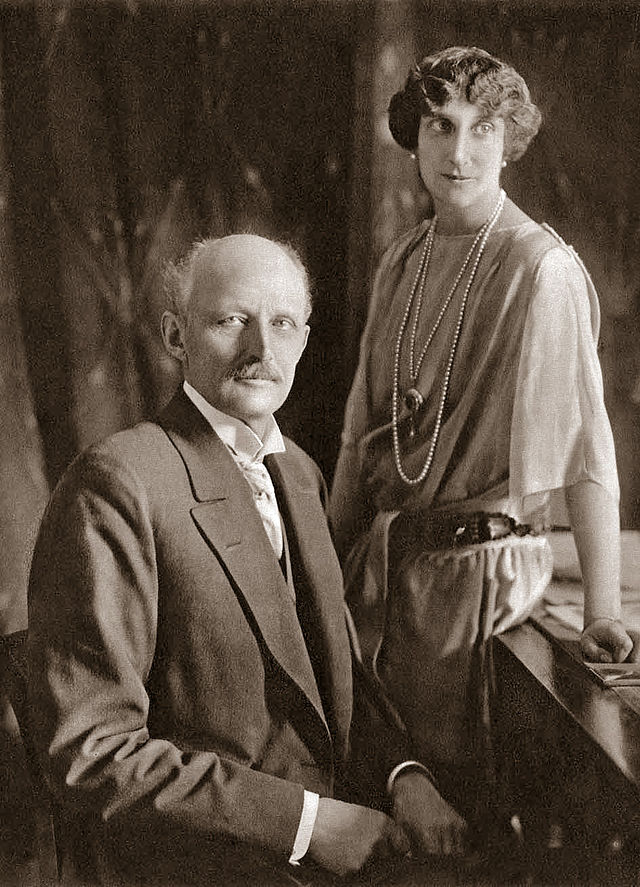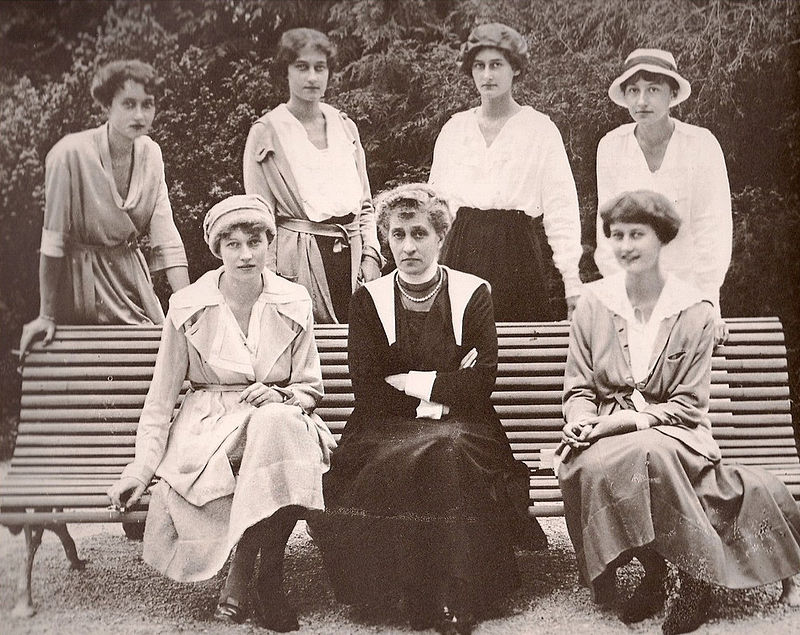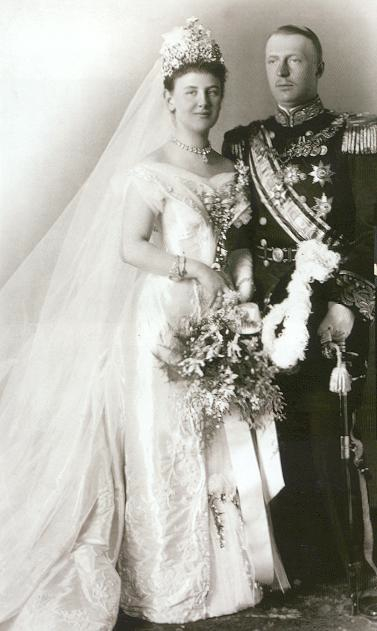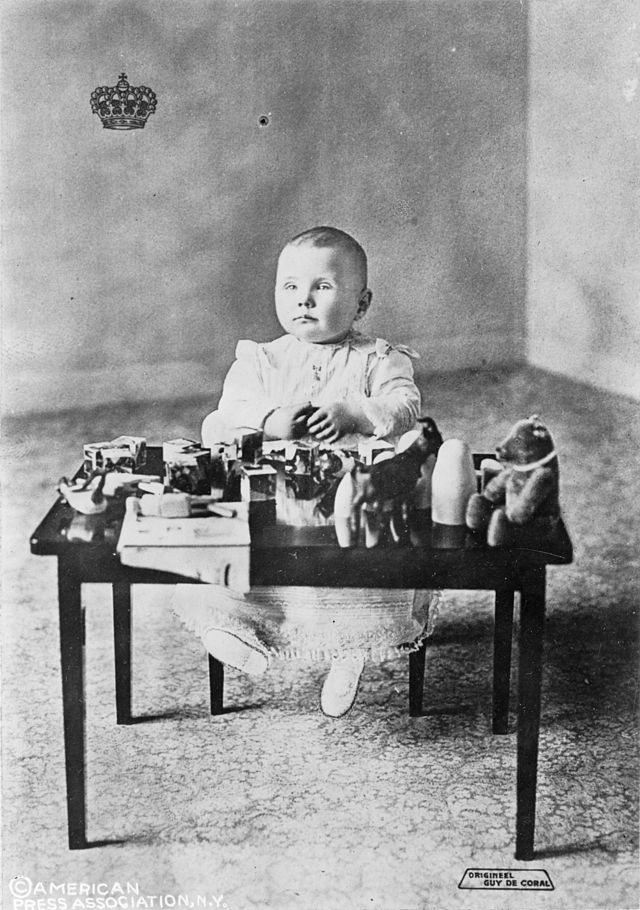by Susan Flantzer © Unofficial Royalty 2015

Queen Juliana of the Netherlands; Credit – Wikipedia
Juliana was Queen of the Netherlands from September 4, 1948 to April 30, 1980 when she abdicated in favor of her eldest daughter Beatrix. Born at Noordeinde Palace in The Hague, the Netherlands on April 30, 1909, Juliana was the only child of Queen Wilhelmina of the Netherlands and her husband Prince Hendrik of Mecklenburg-Schwerin.
Juliana was christened on June 5, 1909, at the Willemskerk in The Hague, the Netherlands. She was given the names Juliana Louise Emma Marie Wilhelmina:
Her godparents were:
- Dowager Queen Emma of the Netherlands, her maternal grandmother, born Emma of Waldeck-Pyrmont
- Grand Duchess of Mecklenburg-Schwerin, her paternal grandmother, born Marie of Schwarzburg-Rudolstadt
- Princess of Schwarzburg-Rudolstadt, her paternal great-grandmother, born Mathilde of Schönburg-Waldenburg
- Princess Marie of the Netherlands
- Grand Duchess of Baden, born Princess Luise of Prussia
- Princess of Erbach-Schönberg, her maternal great-aunt, born Elisabeth of Waldeck-Pyrmont
- Duke Johan Albrecht of Mecklenburg-Schwerin, her paternal uncle
- Duke Adolf Frederik of Mecklenburg, her paternal uncle

Juliana and her mother Queen Wilhelmina in 1914; Credit – Wikipedia, United States Library of Congress’s Prints and Photographs Division
When Juliana was six years old, a small class was formed at Noordeinde Palace so the young princess could be educated with other children. Her classmates were all from Dutch noble families: Baroness Elise Bentinck, Baroness Elisabeth van Hardenbroek, and Jonkvrouwe Miek de Jonge. Juliana continued with this class until the age of eleven when she began studying with private tutors. At the age of 18, Juliana enrolled at Leiden University, where she studied sociology, jurisprudence, economics, history of religion, parliamentary history, constitutional law, and international law. She finished her studies three years later in 1930.
In February 1936, Juliana attended the Winter Olympics in Garmisch-Partenkirchen in Bavaria, Germany. There she met and fell in love with Bernhard of Lippe-Biesterfeld, a prince from a minor German royal house. After Queen Wilhelmina had lawyers draft a very detailed prenuptial agreement that specified exactly what Bernhard could and could not do, the couple’s engagement was announced on September 8, 1936. After a civil marriage at The Hague City Hall, a religious marriage was held at the Grote of Sint-Jacobskerk in The Hague on January 7, 1937. Before the wedding, Bernhard had been granted Dutch citizenship and changed the spelling of his name from German to Dutch, and on his wedding day, he became His Royal Highness Prince Bernhard of the Netherlands.
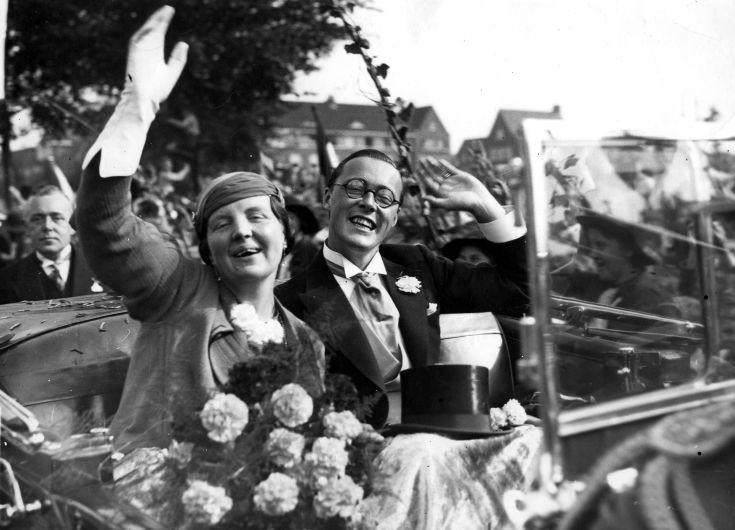
Princess Juliana and Prince Bernhard after their engagement; Credit – Wikipedia
Juliana and Bernhard had four daughters:
- Queen Beatrix of the Netherlands (born 1938), married Claus von Amsberg, had three sons
- Princess Irene of the Netherlands (born 1939), married Carlos Hugo, Duke of Parma, divorced 1981, had two sons and two daughters
- Princess Margriet of the Netherlands (born 1943), married Pieter van Vollenhoven, had four sons
- Princess Christina of the Netherlands (1947 – 2019) married Jorge Pérez y Guillermo, divorced 1996, had two sons and one daughter
During World War II, three days after Germany invaded the Netherlands in May 1940, the Dutch Royal Family left for London, England. One month later, Juliana and her daughters Beatrix and Irene, went to Ottawa, Canada, where they would be safer. Prince Bernhard stayed with Queen Wilhelmina in London during the war, although both made occasional visits to Canada. Juliana’s third daughter Margriet was born while the family was in Canada. On August 2, 1945, the whole family returned to the Netherlands.

Juliana with her mother, husband, and daughters in Ottawa, Canada in 1943; Credit – Wikipedia
After World War II, Juliana served twice as regent (October 14, 1947 – December 1, 1947, and May 14, 1948 – August 30, 1948) due to the ill health of her mother, Queen Wilhelmina. On September 4, 1948, after a reign of nearly 58 years, Queen Wilhelmina abdicated in favor of her daughter, and Juliana became Queen of the Netherlands. Wilhelmina survived until 1962, when she died at the age of 82.
Juliana was a much more relaxed monarch than her mother had been, and this lessened the distance between the royal family and the Dutch people. She often appeared in public dressed like any ordinary Dutch woman, and preferred to be addressed as “Mevrouw” (Dutch for “Mrs.”) rather than her formal “Majesty”. Juliana’s love of bicycling for exercise gave rise to the royal family’s nickname, “the cycling family.”

Queen Juliana riding a bike in 1967; Credit – Wikipedia
Queen Juliana was particularly interested in the problems of developing countries, the refugee problem after World War II, and child welfare. In 1953, the Netherlands suffered its most destructive storm in 500 years. More than two thousand people drowned, and the floodwaters trapped tens of thousands. Queen Juliana quickly visited the areas affected. Outfitted with boots, she comforted the affected people and raised their morale. During her Silver Jubilee in 1973, Queen Juliana donated all the money the National Silver Jubilee Committee raised to organizations that supported children in need around the world.
On January 31, 1980, the birthday of her eldest daughter Beatrix, Queen Juliana announced that she would abdicate in favor of Beatrix on April 30, 1980, her 71st birthday. Juliana indicated she wanted to be styled as Her Royal Highness Princess Juliana. After her abdication, Juliana remained active socially and appeared regularly in public. One of her favorite activities was dining at fine restaurants – a favorite was the Auberge de l’Ill in Illhaeusern in Alsace, France.
After 1995, when Juliana’s general health began to decline, she made fewer public appearances. Her last public appearance was in 1998 at the wedding of her grandson, Prince Maurits. In 2001, during a television interview on the occasion of his 90th birthday, Prince Bernhard said that Juliana no longer recognized her family and had been suffering from Alzheimer’s disease for several years. On Saturday, March 20, 2004, shortly before six o’clock in the morning, Juliana died in her sleep at the age of 94 due to pneumonia, in the presence of her three eldest children.
Juliana’s funeral was held on March 30, 2004, at the Nieuwe Kerk in Delft. She had requested that the color white be the focus of her funeral, and therefore her daughters dressed in white. Princess Christina, Juliana’s youngest daughter and a talented singer who had studied classical music, beautifully sang the Shaker song “Simple Gifts.” As Norwegian composer Edvard Grieg’s familiar Morgenstemning (Morning Mood) played, Prince Bernhard, Queen Beatrix, Princess Irene, Princess Margriet, Princess Christina, and Margriet’s husband Pieter van Vollenhoven followed the casket down the stairs to the royal crypt for the internment. Prince Bernhard survived his wife by eight months, dying at the age of 93 on December 1, 2004.

The access to the royal crypt in the foreground; Credit – By Sander van der Wel from Netherlands – Royal grave tomb and the grave of Willem van Oranje, CC BY-SA 2.0, https://commons.wikimedia.org/w/index.php?curid=28146859
This article is the intellectual property of Unofficial Royalty and is NOT TO BE COPIED, EDITED, OR POSTED IN ANY FORM ON ANOTHER WEBSITE under any circumstances. It is permissible to use a link that directs to Unofficial Royalty.
Kingdom of the Netherlands Resources at Unofficial Royalty










